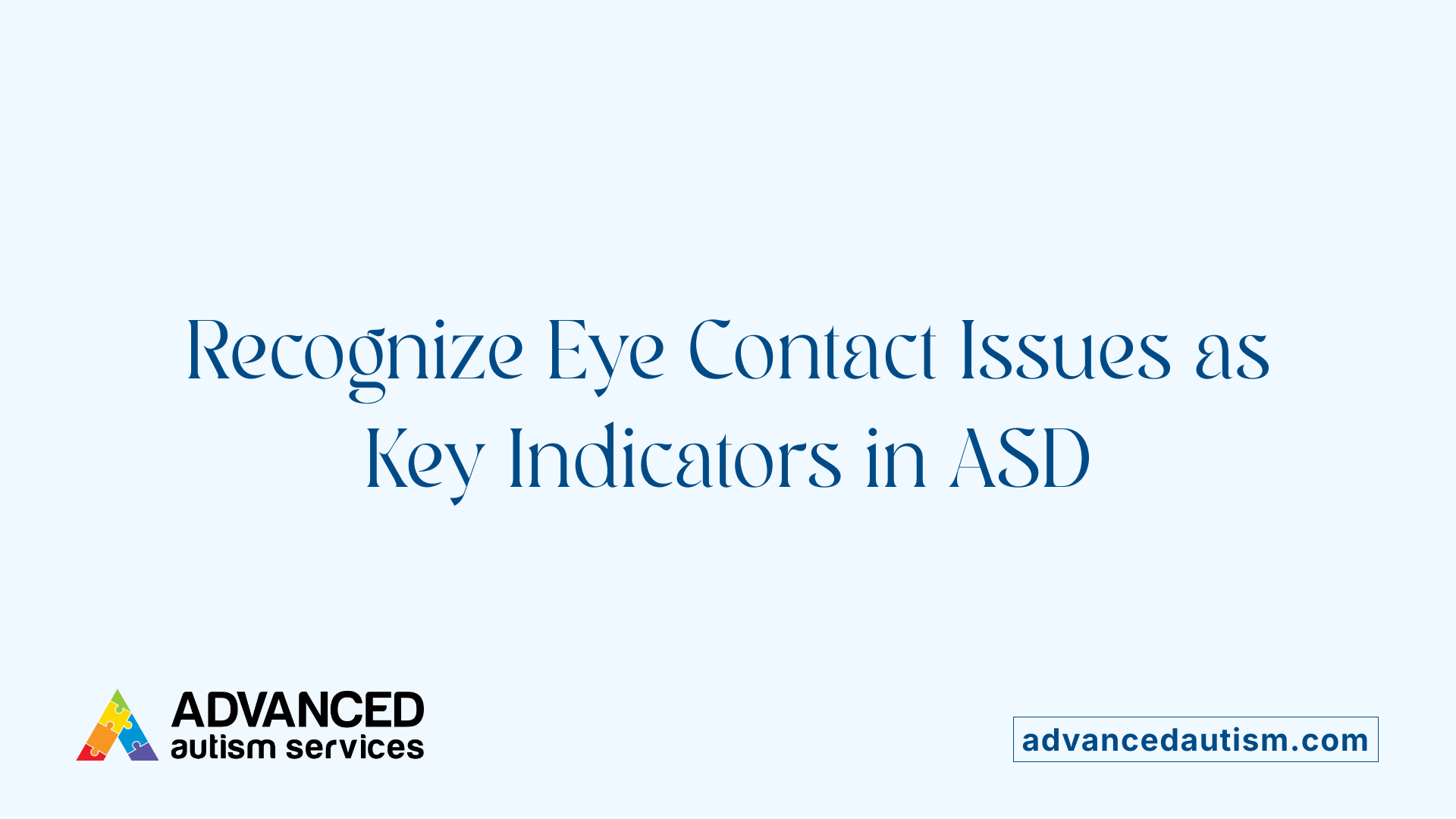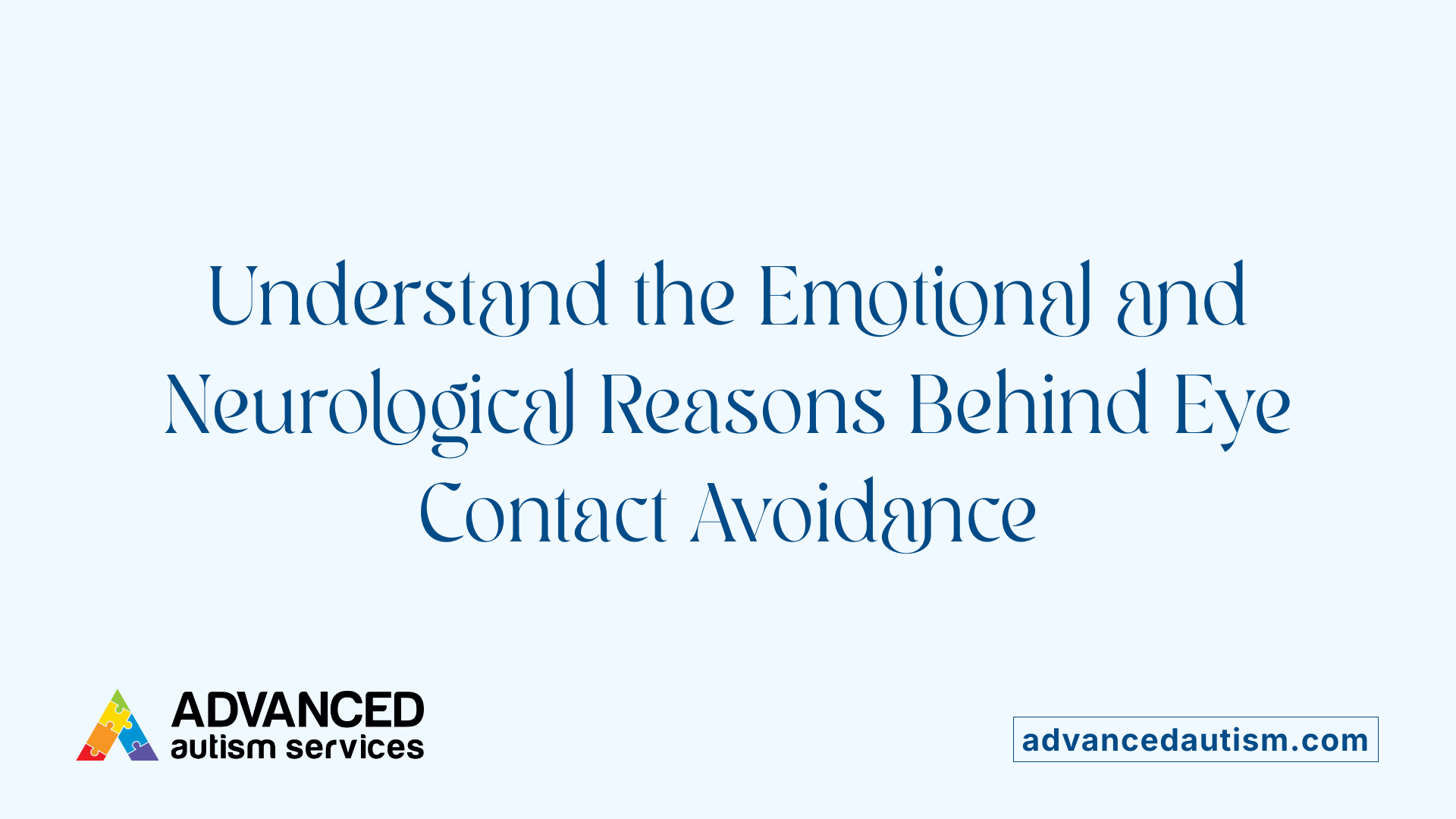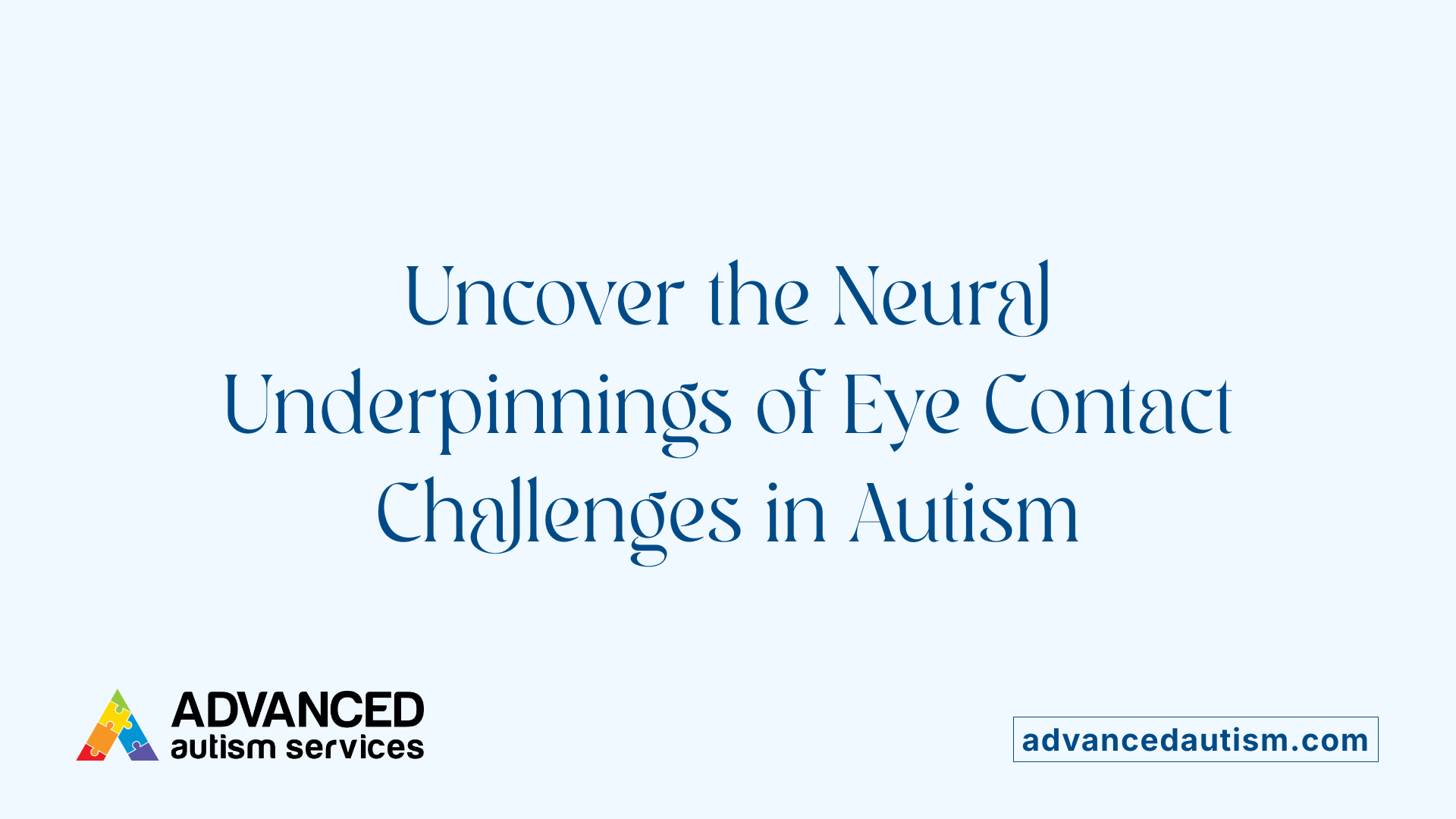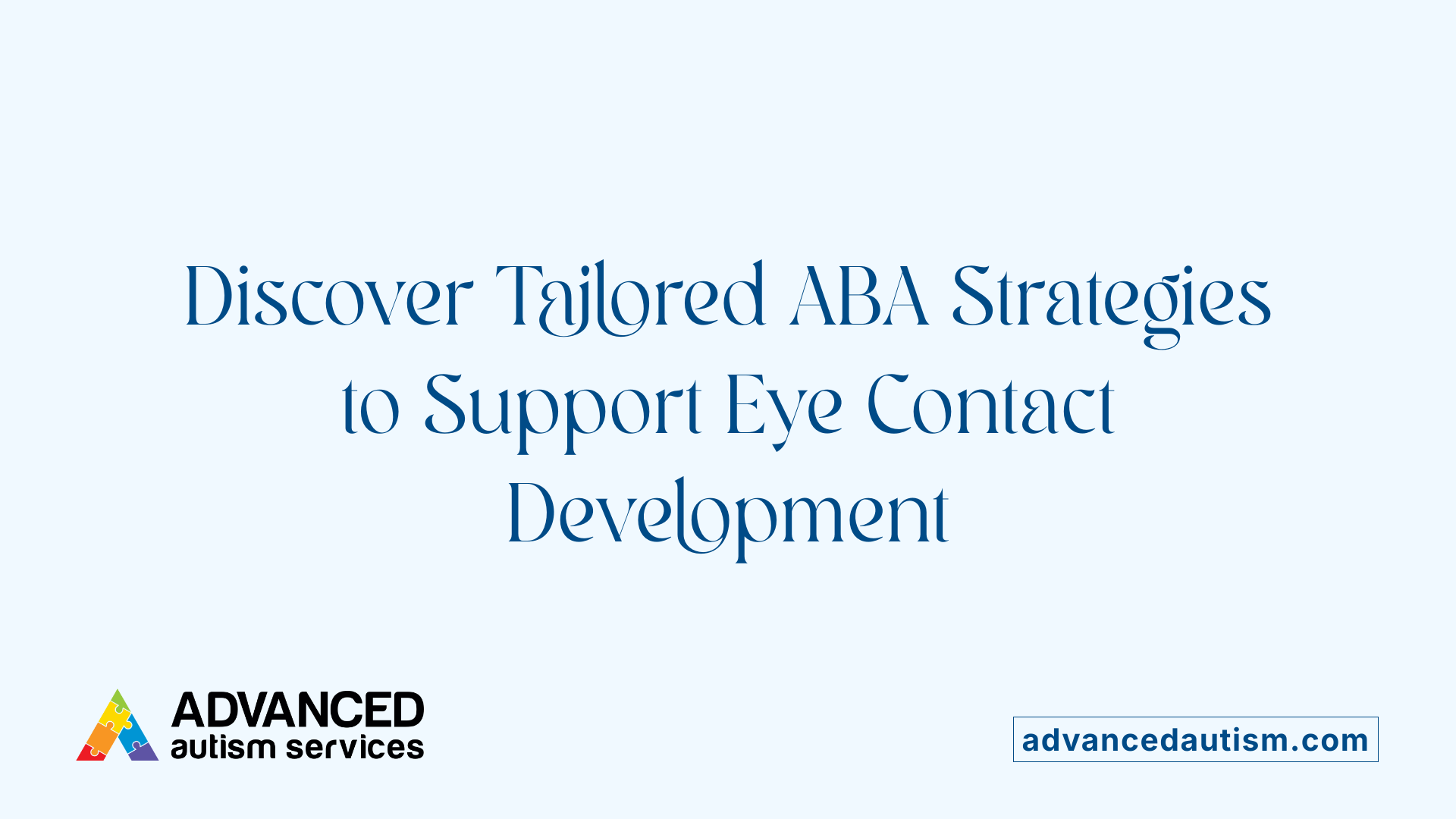Is Lack Of Eye Contact An Autism Symptom?
Unpacking Eye Contact Difficulties in Autism: Causes, Neural Mechanisms, and Supportive Therapies
Understanding Eye Contact in Autism Spectrum Disorder
Eye contact is a fundamental part of human social interaction, yet many individuals with autism spectrum disorder (ASD) experience challenges with it. This article explores why people with autism often avoid or struggle to maintain eye contact, the neurological underpinnings behind this behavior, and effective therapeutic approaches that support improvement in social communication skills.
Eye Contact Difficulties as a Recognizable Symptom of Autism

Is lack of eye contact a symptom of autism?
Yes, lack of eye contact is a common symptom in many individuals with autism spectrum disorder (ASD). It often emerges as one of the earliest recognizable signs, sometimes noticed as early as infancy. Many children with autism avoid or show reduced eye contact, which can be a significant indicator of their social communication challenges.
Prevalence of eye contact avoidance in ASD
A notable number of people with ASD find making eye contact uncomfortable or overwhelming. This behavior is not due to indifference or lack of care but often linked to neurological factors causing stress or anxiety when engaging in direct gaze. Avoiding eye contact is frequently observed across different ages and levels of autism severity, highlighting its significant prevalence.
Early signs of lack of eye contact
Reduced eye contact can be detected very early in development. For caregivers and clinicians, observing a child's failure to meet others' gaze or avoiding eye contact during social interactions might raise early concern or suspicion of autism. This difficulty is sometimes accompanied by challenges in processing other social cues and nonverbal communication.
Social communication challenges related to eye contact
Eye contact plays a crucial role in social interactions, serving as a cue for engagement and understanding. Challenges with eye contact in individuals with autism can contribute to difficulties initiating and maintaining conversations or interpreting others' feelings. These struggles affect overall social development, making it harder for autistic individuals to connect and communicate comfortably.
Recognizing and addressing eye contact difficulties early through supportive strategies can significantly impact social communication outcomes and quality of life for those with ASD.
Neurological Basis for Eye Contact Challenges in Autism
Brain regions involved in eye contact
Eye contact engages several brain regions, notably the dorsal parietal cortex and the subcortical face processing system. The dorsal parietal cortex plays a crucial role in directing visual attention during social interactions. Meanwhile, the subcortical system, comprising the superior colliculus, pulvinar nucleus of the thalamus, and amygdala, is responsible for processing faces and emotions.
Dorsal parietal cortex activity differences in ASD
Individuals with autism spectrum disorder (ASD) show reduced activity in the dorsal parietal cortex during eye contact compared to neurotypical individuals. This decreased activation correlates with the severity of ASD symptoms, as measured by tools like the Autism Diagnostic Observation Schedule (ADOS). The diminished engagement of this brain region may contribute to the difficulty individuals with ASD experience in maintaining eye contact.
Subcortical face processing system overactivation
Functional MRI studies reveal that when gaze is directly constrained to the eye area, individuals with autism exhibit overactivation in the subcortical face processing system. This heightened neural response is especially pronounced when viewing fearful faces but also occurs with happy, angry, and neutral expressions. This overactivation is thought to cause discomfort or a feeling of 'burning' during eye contact, suggesting a neurological basis for the avoidance behaviors observed in ASD.
Neural correlates of social features in autism
The interplay between decreased dorsal parietal cortex activation and overactive subcortical responses highlights an excitatory/inhibitory imbalance in the brains of individuals with autism. This imbalance can result in abnormal reactions to direct gaze, leading to anxiety and stress during eye contact. Understanding these neural mechanisms provides insight into why forced eye contact in therapy might increase distress and supports gradual, controlled exposure methods to improve social engagement in ASD.
Why Avoiding Eye Contact Is Not Indifference

Emotional and sensory discomfort caused by eye contact
Many individuals with autism spectrum disorder (ASD) avoid eye contact not because of indifference, but due to emotional and sensory discomfort. Brain imaging studies reveal that during eye contact, some autistic individuals experience neurological overactivation, particularly in subcortical regions that process faces and emotions. This heightened neural response can trigger feelings of stress or anxiety, making direct gaze overwhelming.
Self-reports describing neurological discomfort
People with autism often describe eye contact as physically and emotionally uncomfortable. Some report that it can "burn" or cause significant distress. These personal accounts align with brain research showing that eye contact activates certain brain areas more intensely in autistic individuals, suggesting a neurological basis rather than simple disinterest.
Excitatory/inhibitory imbalance hypothesis in autism
Research supports the idea that an excitatory/inhibitory imbalance in the autism brain leads to abnormal responses during eye contact. Functional MRI studies have found overactivation in the subcortical face processing system, including the amygdala and thalamus, when individuals with ASD fixate on eyes. This imbalance may amplify emotional reactions and contribute to aversive responses.
Stress and anxiety related to forced eye contact
Forcing eye contact during therapy or social interactions may heighten anxiety for individuals with autism rather than helping. Recognizing the neurological origin of discomfort suggests that gradual, controlled exposure to eye contact is a more effective, less stressful approach. Such strategies support social engagement while respecting sensory sensitivities.
| Concept | Description | Implication for Understanding Autism Behaviors |
|---|---|---|
| Neurological overactivation | Excessive brain response to eye contact | Explains sensory overload and avoidance behavior |
| Self-reported discomfort | Descriptions of eye contact feeling painful or stressful | Highlights the personal experience behind eye contact avoidance |
| Excitatory/inhibitory imbalance | Imbalance in brain signaling causing heightened responses | Provides a biological mechanism for aversive social stimuli |
| Anxiety from forced eye contact | Stress triggered by pressure to maintain gaze | Encourages gradual and positive reinforcement approaches in therapy |
Insights from Brain Imaging Studies on Eye Contact in Autism

Use of functional MRI in studying eye contact
Functional magnetic resonance imaging (fMRI) has been instrumental in examining brain activity related to eye contact in individuals with autism spectrum disorder (ASD). Researchers at the Athinoula A. Martinos Center utilized this technology to capture detailed brain maps during social exchanges involving eye contact, allowing them to observe how neural circuits behave in real-time.
Findings on brain activation during free viewing vs constrained gaze
The studies revealed a striking contrast between brain activation when individuals with autism engaged in free viewing compared to when their gaze was constrained specifically to the eyes. During free viewing, both autistic and neurotypical participants showed similar brain activation patterns. However, when the gaze was fixed on the eye region, individuals with autism exhibited distinct overactivation in certain brain areas, pointing to a difference in how forced eye contact is neurologically processed.
Overactivation patterns with emotional expressions
This overactivation was particularly prominent when participants with autism viewed fearful faces, but heightened responses were also reported with happy, angry, and neutral faces. Such heightened sensitivity to emotional expressions during direct eye contact suggests a neural basis for the discomfort and stress often described by people with autism.
Role of superior colliculus, pulvinar, and amygdala
The subcortical face processing system—which includes the superior colliculus, pulvinar nucleus of the thalamus, and amygdala—was identified as the center of overactivation. These brain structures play crucial roles in processing facial emotions and directing attention to socially salient stimuli. Their hyperactivity may contribute to an excitatory/inhibitory imbalance in the autism brain, which disrupts normal eye contact processing and leads to aversive reactions to direct gaze.
Applied Behavior Analysis (ABA): Therapy Tailored for Autism

What is Applied Behavior Analysis (ABA) Therapy?
Applied Behavior Analysis (ABA) is a scientifically grounded therapy that focuses on improving behaviors and skills in individuals with autism spectrum disorder (ASD). It uses behavioral principles such as reinforcement to encourage positive behaviors and reduce harmful or non-functional ones. ABA is widely recognized as an effective intervention tailored to the developmental needs of autistic individuals, particularly in enhancing social communication and interaction abilities.
Techniques Used in ABA for Autism
ABA therapy breaks down complex social behaviors, like eye contact, into smaller, manageable steps. Techniques include:
- Positive Reinforcement: Offering rewards, praise, or preferred activities when the individual displays desired behaviors, such as making eye contact.
- Shaping Behavior: Gradually molding the behavior by reinforcing closer approximations toward the goal.
- Modeling: Demonstrating behaviors to encourage imitation.
- Prompting: Providing cues or assistance to initiate or sustain the behavior.
- Creating Supportive Environments: Using visual supports and consistency to foster learning.
These methods aim to ensure the child finds practicing new behaviors rewarding and less stressful.
Settings and Delivery of ABA Therapy
ABA interventions are versatile and can be delivered in multiple environments where the child spends time, including:
- Home: Family involvement is essential for generalizing skills and maintaining consistency.
- School: Structured sessions support development of social and communication skills in peer interactions.
Professional behavior analysts or therapists design tailored programs based on individual assessments to meet specific needs. Interventions help children thrive socially and academically by integrating therapy with their daily routine.
Tailored Interventions by Professionals
Trained practitioners develop individualized treatment plans using standardized assessments to target deficits and strengths. These plans focus on:
- Improving eye contact progressively while minimizing distress.
- Enhancing social interactions and communication.
- Reducing behaviors that interfere with learning and socialization.
Early and intensive ABA therapy correlates with greater developmental progress. Its flexible, evidence-driven nature allows customization to each child’s unique profile, promoting successful outcomes over time.
ABA Therapy and Improvement in Eye Contact and Social Interaction

How effective is ABA therapy in enhancing eye contact?
Applied Behavior Analysis (ABA) therapy has demonstrated significant effectiveness in increasing eye contact among children with autism spectrum disorder (ASD). By breaking down complex behaviors into manageable steps, ABA uses positive reinforcement such as rewards and praise to support gradual improvements. This structured approach helps children develop the ability to maintain eye contact, which can be challenging given the neurological and sensory difficulties they often face.
How are research-based structured intervention packages used in ABA therapy?
ABA therapy interventions frequently utilize research-designed packages that guide multiple therapy sessions. For example, studies involving children aged 3 to 22 used standardized assessment tools like the Gilliam Autism Rating Scale (GARS) and the Autism Spectrum Screening Questionnaire (ASSQ) to evaluate behavior before and after treatment. These structured programs incorporate visual supports, modeling, shaping of behavior, and reinforcement of natural eye contact instances to offer clear and measurable progress markers.
What improvements in social skills and behaviors are observed with ABA therapy?
Beyond improving eye contact, ABA therapy simultaneously enhances overall social interaction skills. Children undergoing ABA show reductions in stereotypical and self-injurious behaviors, while increasing engagement and communication with others. Techniques applied facilitate better visual attention and encourage social motivation, helping children interact within various environments like home and school with support from family members.
Why is early and intensive ABA intervention important?
Early and intensive application of ABA techniques correlates strongly with higher success rates in social and developmental gains. Younger children, especially those who initially struggle most with eye contact and social interaction, benefit greatly from early intervention. This timely support can accelerate improvements and contribute to better long-term outcomes in managing ASD social challenges.
Strategies Within ABA to Support Gradual Eye Contact Development
Breaking Down Eye Contact into Smaller Steps
Applied Behavior Analysis (ABA) therapy approaches eye contact challenges by dividing this complex social behavior into manageable, incremental steps. This structured breakdown allows children with autism to gradually build their ability to maintain eye contact without overwhelming them or triggering discomfort.
Positive Reinforcement and Shaping Behaviors
ABA uses positive reinforcement techniques such as praise, rewards, and encouragement to shape and increase eye contact behavior. By rewarding small successes, therapists can motivate children to engage more frequently and comfortably in eye contact, reinforcing natural occurrences and encouraging progression through achievable milestones.
Using Natural Instances and Modeling
Therapists and caregivers often reinforce natural instances of eye contact when they occur spontaneously. Modeling appropriate eye contact during conversations provides children a tangible example to mimic. This method emphasizes gentle encouragement without forcing direct gaze, respecting the child’s comfort level and fostering learning through observation.
Creating a Comfortable, Supportive Environment
An environment tailored to the child’s comfort plays a crucial role. ABA techniques focus on reducing anxiety by ensuring interactions take place in familiar and supportive settings, often involving family members and preferred topics. Visual supports and gestures may be used to prompt eye contact subtly, helping establish a safe space for gradual habituation and social development.
Addressing the Anxiety and Discomfort of Eye Contact in Therapy
Avoiding forced eye contact to reduce stress
Forcing eye contact during therapy sessions can inadvertently increase anxiety and discomfort in individuals with autism spectrum disorder (ASD). This approach may intensify neurological overactivation linked to eye contact, making the experience overwhelming rather than beneficial.
Gradual habituation approach
A more effective strategy is gradual habituation, which introduces eye contact slowly and in controlled settings. Applied Behavior Analysis (ABA) therapy uses this method by reinforcing small steps, like naturally occurring eye contact or brief glances, and building up towards longer, voluntary eye contact over time. This minimizes stress while encouraging social engagement.
Understanding neurological overactivation
Research using functional magnetic resonance imaging (fMRI) has shown that individuals with ASD exhibit overactivation in the subcortical face processing system when their gaze is constrained to the eye region. This includes brain areas such as the amygdala, which is linked to emotional processing, causing eye contact to feel uncomfortable or even painful. Recognizing this neurological basis helps therapists avoid misinterpreting eye avoidance as disinterest.
Tailoring therapy to individual comfort levels
Therapists should customize interventions based on each individual’s tolerance and response to eye contact. By respecting comfort levels and using positive reinforcement, therapy can become a supportive tool rather than a cause of distress. Involvement of families and familiar environments furthers this personalized approach, supporting gradual improvements in social communication.
These approaches highlight the importance of patience, understanding, and a neuroscience-informed framework in supporting eye contact development in autism therapy.
The Importance of Early Intervention and Family Involvement
How does early ABA therapy impact children with autism?
Early intervention using Applied Behavior Analysis (ABA) therapy has a significant positive impact on children with autism spectrum disorder (ASD). Starting ABA at a young age increases the likelihood of developing better social skills, including eye contact and communication. Intensive and early ABA approaches break down social behaviors into manageable steps and utilize positive reinforcement to encourage progress, which helps reduce anxiety and improve engagement.
What role do families and caregivers play in skill generalization?
Families and caregivers are essential in extending the benefits of therapy beyond clinical settings. When parents and caregivers are actively involved, they help children generalize eye contact and social skills across different environments like home, school, and social settings. This involvement includes reinforcing behaviors, modeling social cues, and creating supportive conditions that encourage comfortable and positive social interactions.
How can development be supported in multiple environments?
Supporting children with ASD requires coordinated efforts across various settings. ABA therapy practices are often incorporated into daily routines at home and school, ensuring consistent learning and reinforcement. Strategies such as incorporating familiar faces, using gestures, and discussing topics of interest help children practice eye contact naturally in diverse and comfortable contexts. This multisite support fosters more robust and lasting developmental progress.
What are the long-term benefits for communication and socialization?
Long-term benefits from early and family-supported intervention include enhanced communication abilities and improved social interactions. As children gradually build their eye contact skills and reduce stress associated with direct gaze, they become better equipped to connect with others. These improvements contribute to increased social motivation and decreased behaviors that hinder interaction, setting a strong foundation for healthier relationships throughout their lives.
Summary: Recognizing and Supporting Eye Contact Challenges in Autism
Lack of eye contact is a well-documented symptom often seen in individuals with autism spectrum disorder, rooted in distinct neurological differences that affect social processing and emotional comfort. Recognition that avoidance of eye contact stems from discomfort or sensory overload, rather than indifference, has important implications for therapeutic approaches. Applied Behavior Analysis, with its evidence-based strategies and focus on gradual, positive reinforcement, demonstrates effectiveness in helping individuals with autism improve eye contact and social interactions while minimizing anxiety. Early intervention and active involvement of families ensure the best outcomes in fostering meaningful communication and social engagement.
References
- Why People With Autism Have Trouble Making Eye Contact
- Understanding Eye-contact Avoidance in People With Autism
- The Effectiveness of Applied Behavior Analysis Therapy on ...
- Autism And Making Eye Contact - ABA in Apple Valley, CA
- Is Avoiding Eye Contact a Sign of Autism
- Applied Behavior Analysis (ABA)
- Applied Behavior Analysis (ABA)
- Applied Behavior Analysis in Children and Youth with Autism ...
- The Controversy Around ABA
- Applied Behavior Analysis (ABA) for Children With Autism







